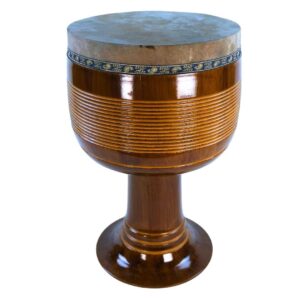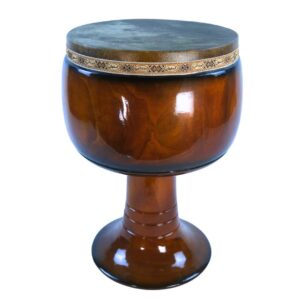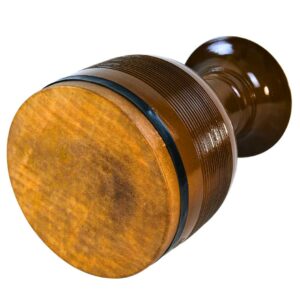- × 1 × € 433,00
- × 1 × € 433,00
Total:
€ 433,00
The tombak stands as one of the most captivating and essential instruments in Persian traditional music, offering a rich tapestry of sounds that have echoed through centuries of Middle Eastern culture. This goblet-shaped drum, with its distinctive hourglass silhouette and mesmerizing tonal range, serves as the rhythmic heartbeat of Persian classical and folk music. Whether you're a seasoned percussionist or just beginning your journey into world music, understanding the tombak opens doors to an ancient musical tradition that continues to inspire musicians worldwide.
At Tapadum Ethnic Music Store, we celebrate these timeless instruments that connect us to diverse cultural heritage. The tombak represents not just a percussion instrument, but a gateway to understanding the sophisticated rhythmic patterns and emotional depth of Persian music.
The tombak, also known as zarb in some regions, traces its origins back over a thousand years to ancient Persia. This instrument has been the cornerstone of Persian music ensembles, accompanying everything from intimate poetry recitations to grand court performances. The name "tombak" itself derives from the onomatopoetic sounds the drum produces – the deep "tom" and sharp "bak" that define its characteristic voice.
Throughout history, master craftsmen have passed down the art of tombak construction through generations. Each instrument represents hours of meticulous work, with the wooden body traditionally carved from mulberry, walnut, or ash wood. The drumhead, typically made from goatskin or lambskin, is carefully stretched and secured to create the perfect tension for optimal sound production.
Persian classical music relies heavily on the tombak's ability to articulate complex rhythmic cycles called "usul." These intricate patterns form the foundation upon which melodic instruments like the tar, setar, and ney weave their musical narratives.
The tombak's distinctive goblet shape isn't merely aesthetic – it's acoustically engineered to produce an extraordinary range of tones. The narrow waist of the instrument creates a resonance chamber that amplifies the drumhead's vibrations, while the flared opening at the bottom allows sound to project with remarkable clarity and volume.
Key construction elements include:
What sets the tombak apart from other frame drums is its incredible tonal versatility. Players can produce deep, resonant bass tones by striking the center of the drumhead, crisp slaps near the rim, and everything in between. Advanced techniques include finger rolls, ghost notes, and the distinctive "riz" – a buzzing sound created by applying pressure while striking.
Mastering the tombak requires developing both technical precision and musical sensitivity. Unlike many Western percussion instruments, the tombak is played primarily with the fingers and palms, allowing for subtle dynamic control and tonal variation that drumsticks simply cannot achieve.
Fundamental playing techniques include:
The tombak serves multiple roles within Persian music ensembles. It provides rhythmic foundation, responds to melodic phrases with complementary patterns, and often engages in musical conversations with other instruments. In solo performances, skilled players demonstrate the instrument's full expressive potential through complex compositions that showcase both technical mastery and emotional depth.
Modern musicians have also embraced the tombak in fusion genres, world music collaborations, and contemporary compositions, proving its versatility extends far beyond traditional Persian music.
For those interested in learning the tombak, the journey begins with understanding basic hand positions and fundamental strokes. Proper posture is crucial – the instrument is traditionally held on the left thigh while sitting cross-legged, though modern players often use stands for performance situations.
Essential practice elements include:
Many excellent instructional resources exist, from traditional Persian music schools to online tutorials and workshops. The key is finding authentic instruction that respects the instrument's cultural origins while making the learning process accessible to modern students.
At Tapadum Ethnic Music Store, we offer carefully selected tombaks that represent the finest in traditional craftsmanship and authentic sound quality. Our ethnic percussion collection features instruments crafted by skilled artisans who understand the precise requirements for professional-quality tombaks.
Whether you're seeking a student-level instrument for learning or a professional-grade tombak for performance, our selection provides options for every budget and skill level. Each instrument in our collection has been personally tested and approved for its tonal quality, construction integrity, and authentic Persian sound characteristics.
Our knowledgeable staff can guide you through the selection process, helping you find the perfect tombak that matches your musical goals and playing style. We also provide detailed information about proper care and maintenance to ensure your instrument delivers years of musical enjoyment.
While deeply rooted in tradition, the tombak continues to evolve and find new expressions in contemporary music. Modern Persian musicians experiment with extended techniques, electronic processing, and cross-cultural collaborations that showcase the instrument's adaptability without losing its essential character.
Contemporary applications include:
This ongoing evolution ensures that the tombak remains relevant and exciting for new generations of musicians while preserving its essential cultural significance.
The tombak represents far more than a percussion instrument – it embodies centuries of Persian musical wisdom, cultural expression, and artistic refinement. Learning to play the tombak connects you to an ancient tradition while developing skills that enhance any musical journey. The instrument's unique combination of technical challenge and emotional expressiveness makes it rewarding for players at every level.
Owning an authentic tombak from Tapadum Ethnic Music Store means possessing not just an instrument, but a piece of living musical heritage. Each tombak carries within it the potential for countless musical discoveries, whether you're exploring traditional Persian repertoire or creating your own contemporary expressions.
The privilege of playing the tombak lies in its ability to transform simple hand movements into profound musical statements. As you develop your relationship with this remarkable instrument, you'll discover that the tombak doesn't just make music – it becomes a voice for emotions and stories that transcend cultural boundaries.
What draws you most to Persian traditional music – the intricate rhythmic patterns, the emotional depth of the melodies, or the cultural stories these instruments help tell?





Mail: info@tapadum.com
Working Days/Hours: Mon – Sun / 10:00 AM – 5:00 PM
Le visite in negozio richiedono un appuntamento